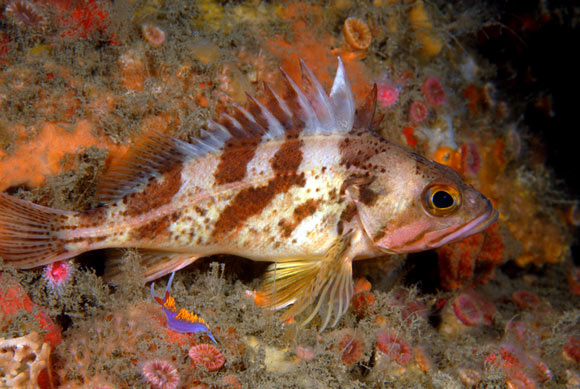A team of researchers from the University of California, Berkeley, and elsewhere has sequenced and analyzed the genomes of 88 Pacific Ocean rockfish species (genus Sebastes) — some species of which are among the longest-living vertebrates known — and unmasked the genetic drivers of longevity evolution, including immunity and DNA repair-related pathways.
Fish have wide variations in lifespan even within closely related species. One such example are the rockfish species found along North Pacific coasts.
Some of these species, like the colorful calico rockfish (Sebastes dallii), live for little more than a decade, while the most long-lived of the genus — the rougheye rockfish (Sebastes aleutianus), which can be found from Japan to the Aleutian Islands — can hang out on the seabed in cold, deep coastal waters for more than 200 years.
Their wide range of lifespans, not to mention differences in size, lifestyle and ecological niche, which scientists call their phenotypes, evolved over a mere 10 million years.
This diversity among closely related species provides a unique opportunity to study the genetic origin and evolution of extreme lifespan adaptations.
“You could think of rockfish as sort of the perfect storm: in some ways, both on an individual level — having individual fish able to live for a really long time because of size and depth adaptations — but also just having all these different species that are showing these different trends,” said senior author Dr. Peter Sudmant, a resercher in the Department of Integrative Biology and the Center for Computational Biology at the University of California, Berkeley.
“They’re a perfect set of individuals to look at, where other people just had a single species to look at.”
To identify the genetic drivers of longevity in Pacific Ocean rockfishes, Dr. Sudmant and colleagues sequenced and performed a genomic analysis of 88 different long- and short-lived species.
They identified repeated signatures of positive selection in DNA repair pathways in long-lived species and 137 longevity-associated genes that affect lifespan both directly, through influencing insulin signaling and other pathways, as well as indirectly, by affecting size and environmental adaptations.
Their findings illustrate the genetic innovations that underlie the diversity of life histories among rockfishes.
The scientists also revealed an expansion of the immunosuppressive butyrophillin gene family in long-lived rockfishes, suggesting that these species have more control over inflammaging, or the increased systemic inflammation with age, which may play an important role in modulating lifespan.
“We can explain 60% of the variation in lifespan just by looking at the size at maturity and the depth at which a fish lives,” Dr. Sudmant said.
“So, you can predict lifespan with pretty high accuracy just from these factors. This allowed us to identify the genes that allow them to do those things.”
“Six different members of the insulin signaling pathway are under selection in these fish,” he added.
“If you look at the textbooks, there’s about nine or 10 core members of the pathway, so the majority of them are under selection in rockfishes.”
“In these rockfishes, we can actually watch the evolution happening over the 10-million-year time period, and we observe that when some species evolve a short lifespan, their population sizes expand, and when they evolve a long lifespan, their population sizes contract,” he said.
“We can see a signature of that in their genomes, in the genetic variation that exists in these species. So, there is a consequence to adapting to long and short life.”
“One intriguing finding is that long-lived species have an excess of certain kinds of DNA mutations — specifically, the conversion of the nucleotide pair CG (cytosine-guanine) to TG (thymine-guanine) — known to accumulate in tumors with aging.”
“Because the oldest females of these long-lived species produce most of the offspring, these unusual genetic alterations are passed along to the rest of the long-lived population.”
The results were published in the journal Science.
_____
Sree Rohit Raj Kolora et al. 2021. Origins and evolution of extreme life span in Pacific Ocean rockfishes. Science 374 (6569): 842-847; doi: 10.1126/science.abg5332








